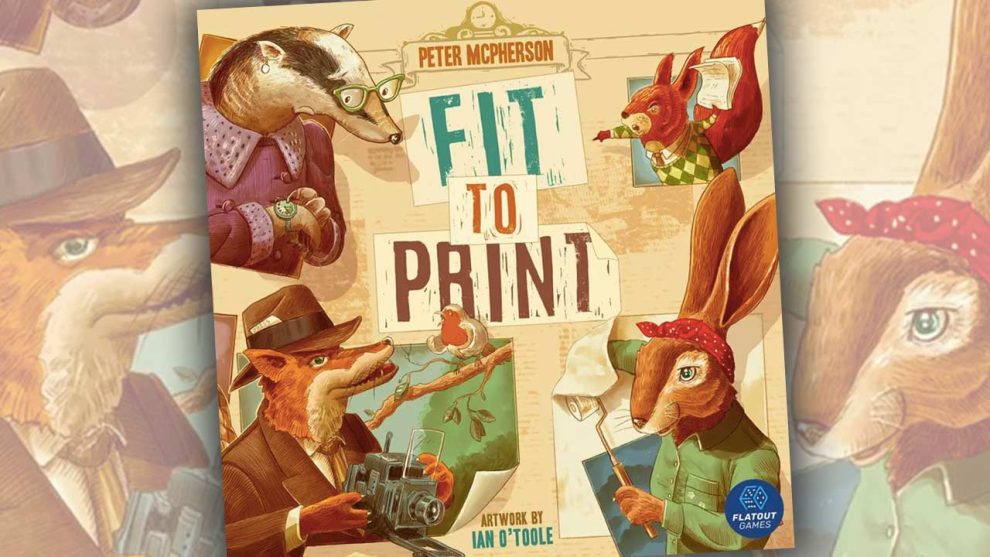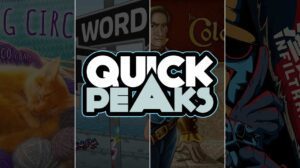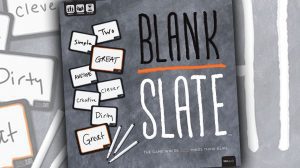Disclosure: Meeple Mountain received a free copy of this product in exchange for an honest, unbiased review. This review is not intended to be an endorsement.
Peter McPherson came out of nowhere in 2019 with his hit game Tiny Towns (a charming game about building tiny settlements for forest dwelling creatures). He followed that success up with several expansions including Tiny Towns: Fortune and Tiny Towns: Villagers, and new title Wormholes in early 2022. We enjoy Peter’s games so much that we’ve interviewed him twice (Feb 2019 and Jan 2022). His approach to design is deceptively simple…friendly and approachable themes, clever and engaging gameplay, and very little player conflict.
Peter’s newest game Fit to Print is also set in the woodlands, the busting town of Thistleville; but this time players aren’t furry general contractors…no, instead they are furry editors-in-chief. That’s right, Fit to Print takes players to the newsrooms of small town papers. Your local newspaper is on a tight deadline and it’s up to you, the loyal editor, to produce an interesting and lucrative front page. The best (worst?) of all is that Fiit to Print is a real time game. It’s not enough to take on the role of an editor, you’ve also got to feel the pressure of getting the front page ready for ink just in time for the Sunday edition! If you think you can handle the heat, then continue on, dear reader.

Fit to Print Overview
In Fit to Print 1-6 players each take on the role of editor-in-chief of a struggling small town newspaper. As the head honcho it’s your job to collect news articles, photos, and ad spots, and arrange them into a balanced and interesting newspaper front page for your readers. Each of these elements is a tile, and your personal player board is the front page. Over the course of three rounds / days ( Friday, Saturday, and Sunday) you’ll try to collect the most points by arranging these tiles according to a set of guidelines.
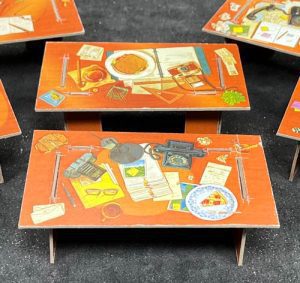 Fit to Print requires very little setup: each player gets a 3D news desk and a newspaper of their choice with one side showing the available space for Friday’s and Saturday’s front pages, while the opposite side shows Sunday; each subsequent day increases the space you have to work with. Players are also dealt a random editor-in-chief card, each of which provides a unique game-changing special ability, and a starting Centerpiece tile; placing this anywhere on your front page player mat (making sure the Centerpiece tile covers the star). Centerpiece tiles provide game-breaking rules changes or bonus scoring options. Finally all the newspaper tiles (articles, photos, and ads) are placed face-down on the table and mixed about thoroughly.
Fit to Print requires very little setup: each player gets a 3D news desk and a newspaper of their choice with one side showing the available space for Friday’s and Saturday’s front pages, while the opposite side shows Sunday; each subsequent day increases the space you have to work with. Players are also dealt a random editor-in-chief card, each of which provides a unique game-changing special ability, and a starting Centerpiece tile; placing this anywhere on your front page player mat (making sure the Centerpiece tile covers the star). Centerpiece tiles provide game-breaking rules changes or bonus scoring options. Finally all the newspaper tiles (articles, photos, and ads) are placed face-down on the table and mixed about thoroughly.
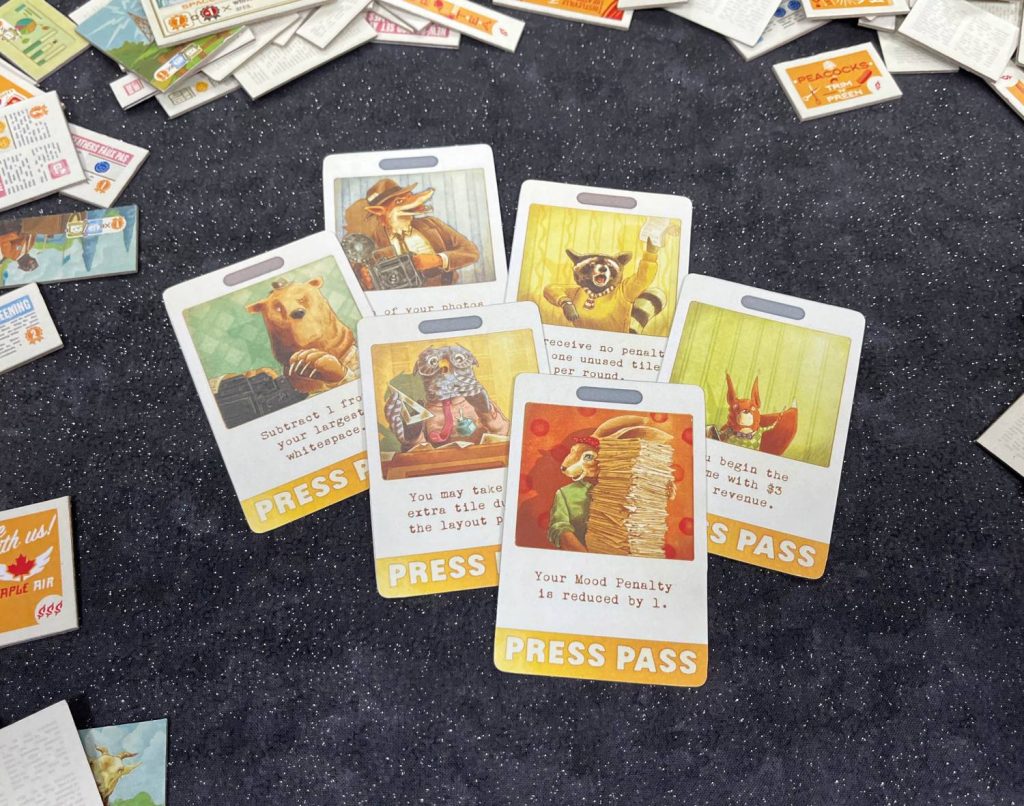
Because Fit to Print is a real time game, the last thing you’ll do before starting is to decide the pace of each round. The rules offer 3 options: Relaxed (5 minute rounds), Standard (4 minute rounds) and Frantic (3 minute rounds). Set the timer, and you’re off!
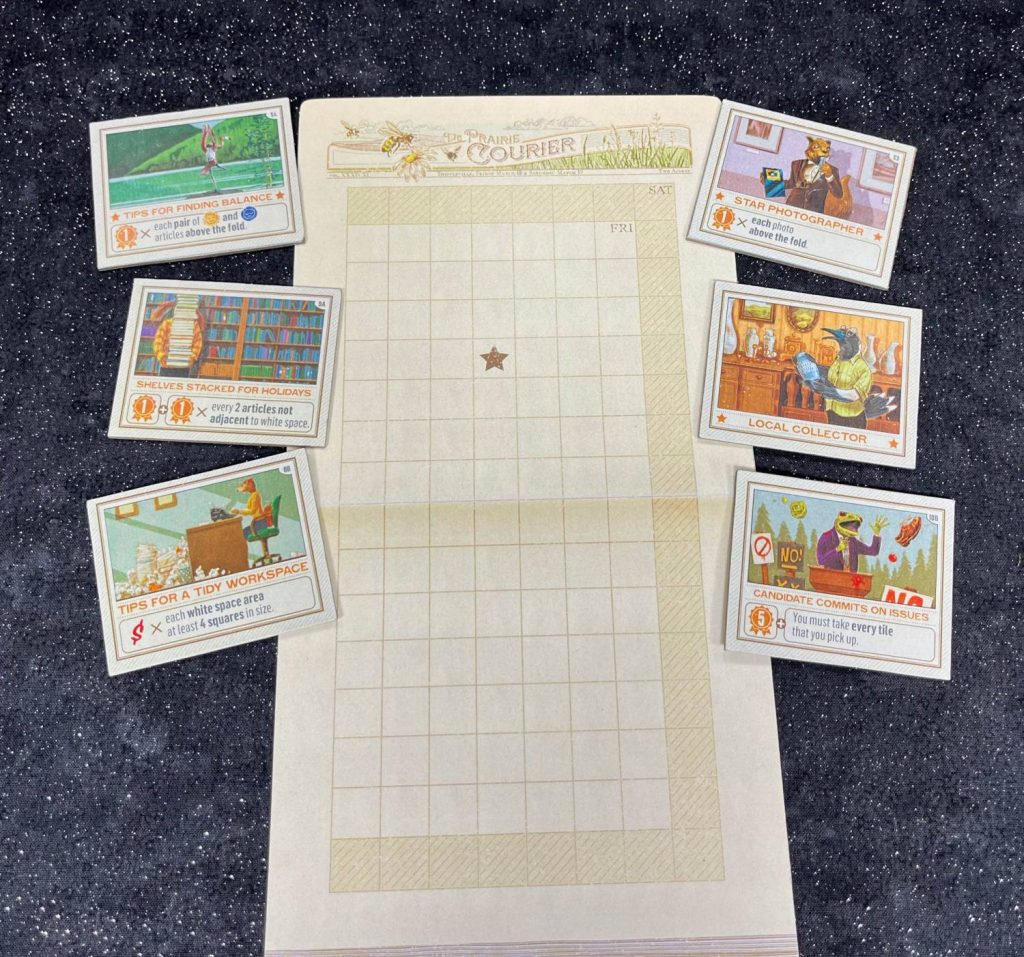
A Day in the Life of a Newspaper Editor
A round consists of two phases: Reporting and Layout. Only you can decide how long to spend in the Reporting phase, but be aware that the timer includes both phases so make sure you give yourself enough time to complete your Layout.
Reporting Phase
When the timer starts you begin picking up face down tiles and deciding if you want to use them in your paper. If you decide to keep the tile, you place it on your news desk and pick up the next tile. To prevent you from just rooting through the pile, you’re restricted to using just one hand. After you’ve placed a tile onto your newsdesk it can’t be returned to the table.
Once you’ve decided you have all the tiles you need to complete your front page you say “layout” and move on to the Layout Phase. Note that once you’re done with the Reporting Phase you may not pick up additional tiles.
Layout Phase
During this phase you’ll take the tiles you selected and arrange them onto your newspaper front page. Since the tiles are at the beating heart of your front page, and of your newspaper, let’s examine these a bit more closely. The tiles come in three main types: articles, photos, and ads (which will earn revenue for your paper at the end of each round).
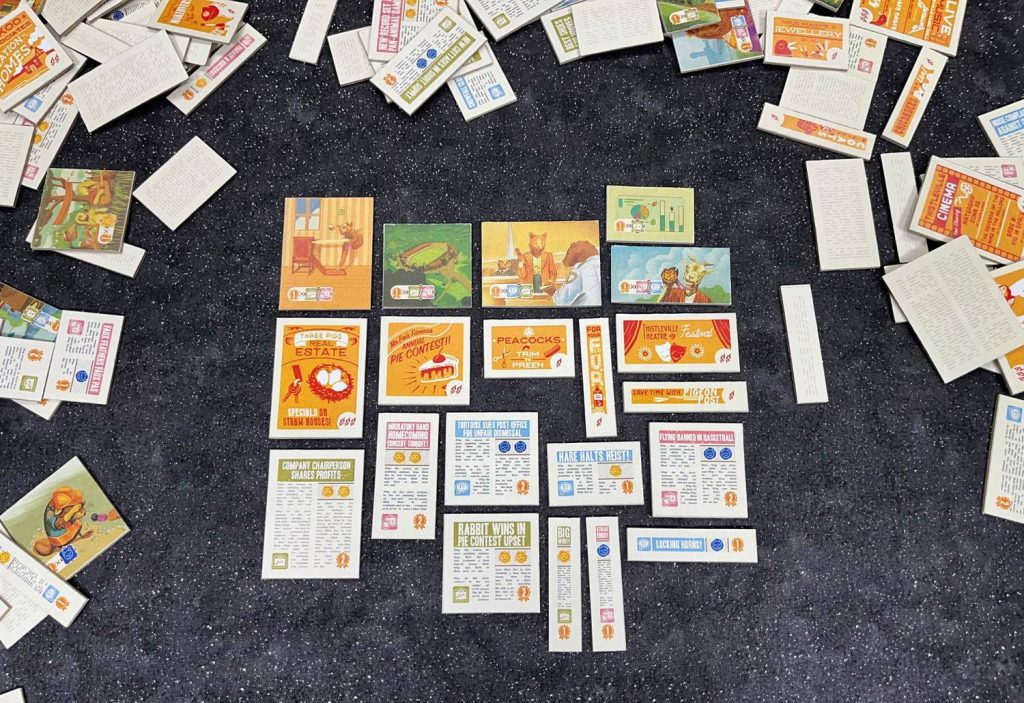
Articles come in three different categories: pink Sports and Entertainment, blue News, and green Business & Technology. Articles of the same category (color) cannot be placed next to each other. Each article tile also has a “mood” (1 or 2 happy or sad icons) which I’ll talk about in a moment. The point value of each article appears at the bottom of each tile.
Photos provide visual interest, and score for being next to articles of a specific category, or in some cases of a specific mood. Photo tiles cannot be placed next to each other. Each photo scores 1 point for each matching article it appears next to. Clever players can earn lots of points for photos.
Ads earn income for your paper, but don’t provide any in-game value until the very last round (more on that in a bit). Ad tiles cannot be placed next to each other. The dollar amount of an Ad appears at the bottom of each tile.
Mood
Like any good editor you’re telling a story with your front page, but your readers want balance. As you add articles to your front page you’ll need to monitor the number of smiley and frowny icons. A balanced front page will have exactly the same of each number. For each icon you have out of balance you’ll lose 1 point.
Whitespace
You’re not getting paid to have empty space in your layout. At the end of each round all players will tally up the number of squares in their largest area of adjacent empty squares. The player with the smallest whitespace area gets a 3 point bonus, while the player with the largest whitespace area receives a 1 point penalty. All other players get a 1 point bonus.
Scoring
Once you’re done with your layout you’ll take the top tile from the stack of Finishing tokens (a set of numbered stopwatches set off to the side at the beginning of the game). After all players are done, each player will score their front page according to the rules mentioned above.
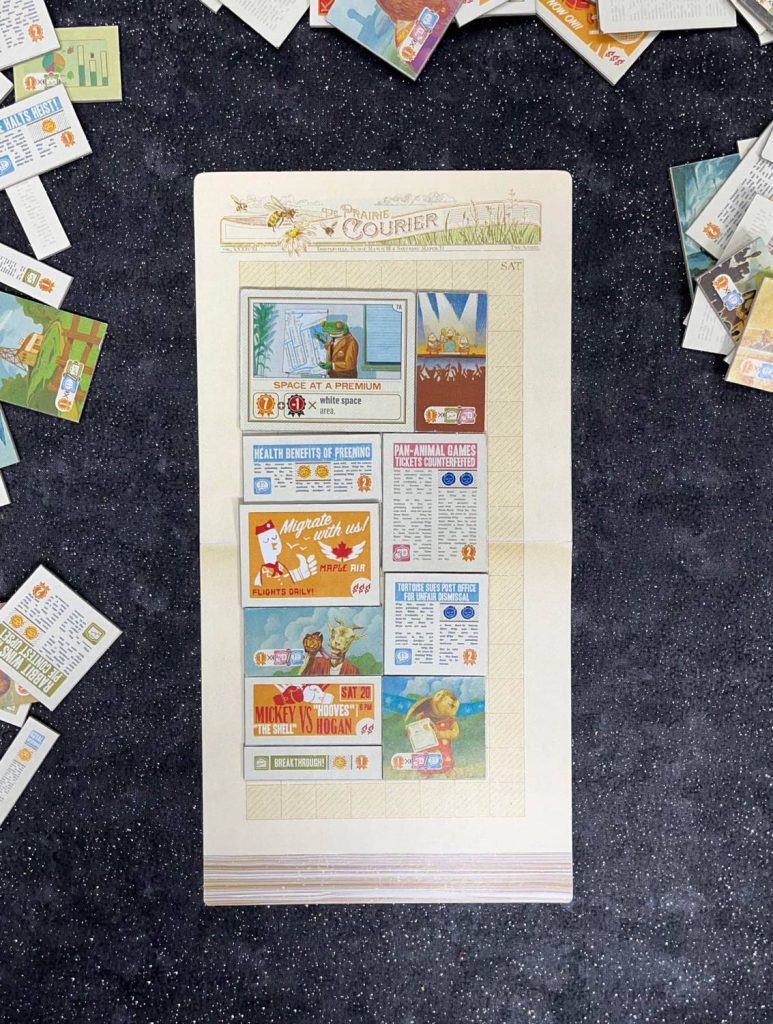
But first, pass your front page to another player so they can confirm that all tiles are placed correctly. Any adjacent ads, photos, or articles (of the same category), must be flipped over and will not count towards scoring (thankfully they also don’t count towards whitespace).
Players should also review what scoring bonuses they might receive thanks to their Centerpiece tile. Then Mood penalties and Whitespace bonuses and penalties are determined.
Any tiles which were not able to be placed from your news desk to your front page will give you a 1 point penalty.
Lastly each player tallies up their Ad revenue.
If this was the last round, add up the Ad revenue accumulated in each of the 3 rounds. The player with the lowest Ad revenue immediately goes out of business and cannot win the game (even if they had the most points). The remaining player who has the most points wins the game.
If this was not the last round, all tiles are returned to the middle and shuffled. In order of Finishing tokens, players select a new Centerpiece tile, then start the next round.
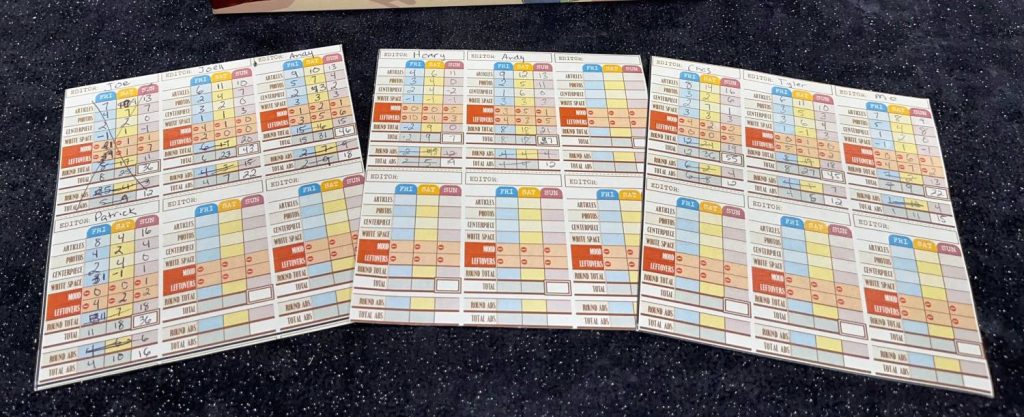
That’s a Wrap
Fit to Print was one of my most anticipated games of the year, in fact it was picked as most anticipated by two of us on the Meeple Mountain team. I just love Peter’s designs. They’re really fun, and always have a sense of playfulness about them, as evidenced by the themes he chooses. When I heard that Fit to Print was picked up by Flatout Games I knew the result would be something special. I’ve been fortunate enough to have had the chance to review early prototypes of Calico, Cascadia, and now Fit to Print, and it’s really an honor to be among the first to see the greatness in these games (Cascadia did go on to win the Spiel des Jahres after all). So when the team at Flatout Games asked me if I’d like to review Fit to Print, I jumped at the chance.
Fit to Print is a tense but enjoyable game of tile-laying and deadline-hitting, wrapped up in a cute and cuddly package. The artwork from Ian O’Toole will win your heart over and the gameplay from Peter will activate your brain with the multi-layered puzzle. Remember that it’s not enough to have the right sized tiles, they also have to be the right types: articles of the same category can’t be next to each other, nor can you have ads and photos adjacent. Plus you have to find the right tiles from a face down stack, identify them, remember what you already have on your newsdesk, and still give yourself time to do the Layout phase where you will inevitably get something wrong, leave too much whitespace, have an imbalanced mood, or forget the special ability of your editor card or Centerpiece tile.
Glorious right?
I’ve reviewed several real time games here on Meeple Mountain (Paramedics: Clear, Pile-Up Rush), as well as playing others (FUSE) and while they’re not usually my personal favorites, they do provide a unique experience–one that some players don’t enjoy. Thankfully in addition to the standard real-time version of Fit to Print, Peter and the Flatout Games team also built in a “slo-mode” for people who don’t like real-time games. This was a nice touch and is a good way to learn the ropes without the pressure of the clock.
One odd choice was the “going out of business” rule. It’s not an “if”, it’s a “who”: in any multiplayer game at least one player will have the lowest revenue and be ineligible to win the game. On the surface that feels a bit harsh…especially since player elimination games are on the decline. That said, the “going out of business” doesn’t happen until the very end which gives players the ability to address their ledger sheet, especially since Ad revenue is public knowledge. I will say though that going out of business is highly thematic since if you don’t bring in the revenue, you can’t pay your bills. I was actually fortunate to have won a 3 player game with this rule. Both other players had higher scores than I did (45 and 55 to my 22), but both players were tied for the lowest ad revenue and so they both went out of business. How satisfying!
[Editor’s note: the designer has clarified that in a tie for lowest ad revenue, no one would go out of business. This means that Andy would not have won the game with the above scores.]Hey, Nicholas! No one goes out of business in the case of a tie for lowest.
— Peter McPherson (@peterlmcpherson.bsky.social) (@PeterLMcPherson) August 30, 2023
The biggest challenges I encountered in my plays were the “my eyes are bigger than my stomach” syndrome, and the “color blindness”. In your first play you’re almost certainly going to take too many tiles which will leave you with a hefty penalty after the Layout round. Another thing you’ll almost certainly do is to place ads, photos, and articles of the same type next to each other. You’ll be in such a rush that even though it’s glaringly obvious, you just won’t see it until after the clock is done. Then you look down at your wreck of a home page and raise a mild curse word or two…”fiddlesticks”, “zoinks”, “great googly moogly”, or if you’re particularly frustrated you might break out the grawlix “@#$%&!” (although I’m not sure how you pronounce those symbols).
My main takeaway from my plays of Fit to Print is that Flatout Games continues to prove that they’re one of the most creative and innovative publishers around. They continually present games which have unique themes and tight puzzly gameplay (Public Market, Point Salad, and Dollars to Donuts).
And so if Peter McPherson’s whimsical designs, and Flatout Games’ puzzly pedigree attracts you, then Fit to Print might just be the headline you’ve been looking for.


